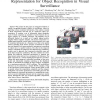11 search results - page 2 / 3 » Agnostic Active Learning Without Constraints |
NN
2002
Springer
13 years 4 months ago
2002
Springer
Recognition-by-components is one of the possible strategies proposed for object recognition by the brain, but little is known about the low-level mechanism by which the parts of o...
DAC
2005
ACM
13 years 6 months ago
2005
ACM
The need to reuse the performance macromodels of an analog circuit topology challenges existing regression based modeling techniques. A model of good reusability should have a num...
TCSV
2011
12 years 11 months ago
2011
—We present in this paper an integrated solution to rapidly recognizing dynamic objects in surveillance videos by exploring various contextual information. This solution consists...
CVPR
2006
IEEE
13 years 11 months ago
2006
IEEE
Part-based tree-structured models have been widely used for 2D articulated human pose-estimation. These approaches admit efficient inference algorithms while capturing the import...
AGENTS
2001
Springer
13 years 9 months ago
2001
Springer
Through adjustable autonomy (AA), an agent can dynamically vary the degree to which it acts autonomously, allowing it to exploit human abilities to improve its performance, but wi...

